
The Bollman Truss Railroad Bridge across the Little Patuxent River at Savage, Maryland, is one of the oldest standing iron railroad bridges in the United States and the sole surviving example of a revolutionary design in the history of American bridge engineering. The 160-foot (48.8 m) double-span was built in 1852 at an unknown location on the main line of the Baltimore and Ohio Railroad. It was moved 35 years later to its present location, where it replaced the very first Bollman bridge. Today, it carries the Savage Mill Trail.

The Poffenberger Road Bridge, near Jefferson, Maryland, is a wrought iron bridge by the Wrought Iron Bridge Company of Canton, Ohio. The bridge is similar to the Fourpoints Bridge elsewhere in Frederick County. The bridge is a single-span double-intersection Pratt truss. It was built circa 1878 and remains in daily use.
The Wrought Iron Bridge Company was a bridge fabrication and construction company based in Canton, Ohio, United States. It specialized in the fabrication of iron truss bridges and was a prolific bridge builder in the late 19th century. It was one of the 28 firms consolidated by J. P. Morgan into the American Bridge Company in 1900. Many of its bridges have been listed on the National Register of Historic Places.

The Fremont Mill Bridge near Anamosa, Iowa was built in 1873. Its superstructure was designed and built by Massillon Iron Bridge Company and its foundations were built by James Milne. It is a wrought iron bowstring through arch bridge.
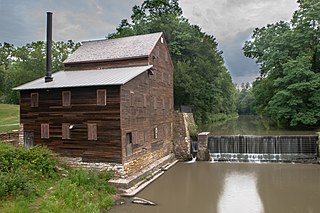
Pine Creek Gristmill is a historic building located in Wildcat Den State Park in Muscatine County, Iowa, United States. The building was listed on the National Register of Historic Places in 1979.

The Upper Paris Bridge is a historic structure located near the town of Coggon in rural Linn County, Iowa, United States. The pin-connected Whipple through truss bridge was built in 1879 as a wagon bridge. It was designed by the Wrought Iron Bridge Company of Canton, Ohio. The bridge was listed on the National Register of Historic Places in 1998 as a part of the Highway Bridges of Iowa MPS.
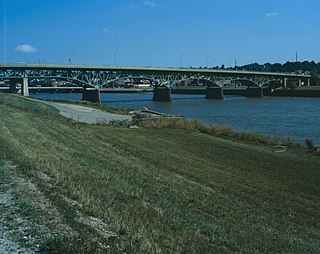
The Jefferson Street Viaduct is a historic structure located in Ottumwa, Iowa, United States. The riveted Warren deck truss bridge was completed in 1936. It was listed on the National Register of Historic Places in 1998 as a part of the Highway Bridges of Iowa MPS.

The Cascade Bridge is a historic structure located in Burlington, Iowa, United States. In April 1896 the Burlington City Council approved a proposal to have city engineer S.D. Eaton advertise for plans and estimates for a bridge on Main Street that would span Cascade Ravine. The Cascade Lumber Company had petitioned for the bridge. The city contracted with the Cedar Rapids, Iowa firm of Boynton & Warriner to design the structure and the Milwaukee Bridge and Iron Works to erect the span. The city was responsible for building the concrete substructure. The bridge was completed in the fall of 1896, and is composed of four spans. The span length is 160 feet (49 m), and its total length is 464 feet (141 m). The span is a Baltimore deck truss bridge with Pratt deck trusses at both ends. The structure is supported by stone and concrete abutments with concrete pedestals and a single concrete-filled steel cylinder pier. Over the years the original deck has been replaced, and concrete has been applied to the stone abutments. Otherwise the structure has been unaltered. The bridge was listed on the National Register of Historic Places in 1998.

The Wapsipinicon River Bridge is a historic structure located in Independence, Iowa, United States. It spans the Wapsipinicon River for 341 feet (104 m). The Buchanan County Board of Supervisors contracted with the Miller-Taylor Construction Company from Waterloo, Iowa, to build the new bridge on the south side of Independence for $37,680. However, high water created problems during construction, and the bridge was completed in January 1927 for $57,530. It replaced an earlier two-span iron truss bridge. This bridge is a concrete filled spandrel arch bridge with four spans. It was designed by the Iowa State Highway Commission, and continues to carry vehicle traffic. The bridge was listed on the National Register of Historic Places in 1998. There is a similar bridge upstream in Independence that was built in 1918.

Nodaway River Bridge is located west of Grant, Iowa, United States. It spans an arm of a small pond in Pilot Grove County Park for 70 feet (21 m). The Montgomery County Board of Supervisors accepted a petition from S. M. Smith to build a bridge over the Nodaway River south of Grant in June 1876, and another bridge over the Nishnabotna River at the same time. The county contracted with the Missouri Valley Bridge & Iron Co. of Leavenworth, Kansas, to design and build the Nodaway River bridge, which was completed later the same year for $1,000. The bridge consists of a single-span Bowstring arch-truss with a wood deck. It remained in use as a road bridge until 1968, when it was moved to the park for use as a pedestrian bridge. Even though it is no longer in its historic location and used for its historic function, the bridge was listed on the National Register of Historic Places in 1998 as an example of early transportation development in Iowa.

Red Bridge is a historic structure located northeast of Postville, Iowa, United States. It spans the Yellow River for 128 feet (39 m). The Allamakee County Engineer designed the timber Pratt through truss structure, and it was erected by a local contractor named A. L. Powell in 1920. Built for $2,304.74, it is composed of timber compression members and forged iron tension members. The structural steel was provided by the Worden-Allen Company of Milwaukee, and City Lumber provided the timbers. At some point it was abandoned and the timber deck and stringers were removed. It is the last uncovered timber truss bridge remaining in Iowa. The bridge was listed on the National Register of Historic Places in 1998.

The Elkader Keystone Bridge is a historic structure located in Elkader, Iowa, United States. The old iron truss bridge that crossed the Turkey River at this location was declared unsafe in 1888. The Clayton County Board of Supervisors decided to construct a bridge of native limestone as way of saving money and providing a reliable crossing. Engineer M. Tschirgi designed the structure and Dubuque stonemasons Byrne and Blade constructed the bridge. It was built at a cost of $16,282, and spans the river for 346 feet (105 m). This is one of the largest twin arched keystone bridges west of the Mississippi River. A sidewalk was added on the north side of the structure in 1924. The bridge was individually listed on the National Register of Historic Places in 1976.
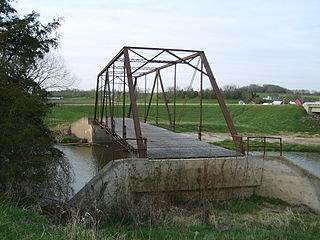
Mill Race Bridge is a historic structure located northwest of Eldorado, Iowa, United States. It spans the Turkey River for 120 feet (37 m). Its name is derived from its location near a riverside mill. Horace E. Horton, a civil engineer from Minneapolis, had designed wagon bridges for Fayette County in the 1880s. When he joined the Chicago Bridge & Iron Company late in the decade, he took the county with him as a client. Chicago Bridge & Iron was responsible for providing the county's bridges in the 1890s. This bridge was completed about 1892, but its concrete abutments are not original. While it remains in place, but it has been replaced by a newer span. The Mill Race Bridge was listed on the National Register of Historic Places in 1998.

Hale Bridge is a historic structure located south of Anamosa, Iowa, United States. It spans the Wapsipinicon River for 296 feet (90 m). It is an example of a bowstring through-arch truss bridge. Perhaps thousands of these bridges were built in Iowa in the late 1860s through the 1870s. However, by 1992, fewer than twenty survive.
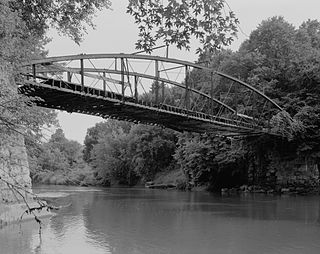
Corbett's/Eby's Mill Bridge is a historic structure located northeast of Scotch Grove, Iowa, United States. It spans the Maquoketa River for 128 feet (39 m). James S. Applegate established a gristmill near this location in 1858. He was joined by John Corbett, who obtained ownership by 1868 and expanded the operation and added a sawmill. He petitioned the Jones County Board of Supervisors for an iron bridge at this location in 1870. They agreed to pay two-thirds of the construction costs with the final third paid for by local subscriptions. The contract to construct this bridge and a similar span in Monticello was made with Miller, Jamison & Company of Cleveland. Both are single span bowstring truss bridges that were completed in November 1871. This bridge has always been identified with the mill. Samuel Eby acquired it in 1875, and it remained in the family until 1913. The bridge was originally on a loop road that circled behind the mill pond. When County Road X73 was created in 1958 it bypassed the bridge to the south. The bridge has been under private ownership ever since. It was listed on the National Register of Historic Places in 1985.
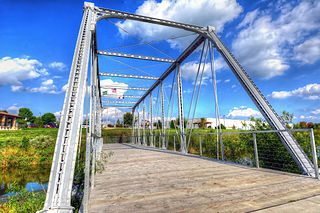
The Dunleith and Dubuque Bridge, also known as the White Water Creek Bridge and the Bergfeld Recreation Area Bridge, is a historic structure located in Dubuque, Iowa, United States. This span was part of a seven-span approach to one of the first bridges constructed over the Mississippi River. It was part of a railroad bridge that connected Dubuque with Dunleith, Illinois, now known as East Dubuque. The bridge was fabricated by the Keystone Bridge Company of Pittsburgh, Pennsylvania. Andrew Carnegie himself traveled to Dubuque to advocate for his company to build the bridge. The bridge was erected by Reynolds, Saulpaugh and Company of Rock Island, Illinois. The approach, of which this iron truss was a part, was completed in 1872. It was used by the Illinois Central and other railroads.
The Fish Creek Bridge is a historic structure that was originally located east of Salem, Iowa, United States. The span carried Hickory Road over Fish Creek for 50 feet (15 m). It is a small-scale, wrought-iron bridge that the Henry County Board of Supervisors bought from the George E. King Bridge Company of Des Moines in 1893 for $410.80. It was believed to have been fabricated by their parent company, King Iron Bridge Company of Cleveland, and assembled by local laborers. Its historical significance derived from its being an uncommon variant of the Pratt truss. It was listed on the National Register of Historic Places in 1998. Subsequently, the bridge has been replaced at its original location, and the historic structure was moved to Oakland Mills Park.

The New Hampton Pony Pratt Truss Bridge is a historic pony Pratt truss bridge on Shoddy Mill Road in New Hampton of Lebanon Township, Hunterdon County, New Jersey. It crosses the Musconetcong River between Lebanon Township, Hunterdon County and Washington Township, Warren County. It was designed by Francis C. Lowthorp and built in 1868 by William Cowin of Lambertville, New Jersey. The bridge was added to the National Register of Historic Places on July 26, 1977 for its significance in engineering, industry and transportation. It is one of the few early examples of iron Pratt truss bridges remaining in the United States. It was later documented by the Historic American Engineering Record in 1991. It was added as a contributing property to the New Hampton Historic District on April 6, 1998.

The Main Street Bridge, once known as the West Main Street Bridge, is a historic pony Pratt truss bridge crossing the South Branch Raritan River in Clinton of Hunterdon County, New Jersey. It was designed by Francis C. Lowthorp and built in 1870 by William Cowin of Lambertville. The bridge was added to the National Register of Historic Places on September 28, 1995 as part of the Clinton Historic District. It is one of the few early examples of iron Pratt truss bridges remaining in the United States. It was documented by the Historic American Engineering Record in 1991.

The Glen Gardner Pony Pratt Truss Bridge is a historic pony Pratt truss bridge on School Street crossing the Spruce Run in Glen Gardner of Hunterdon County, New Jersey. It was designed by Francis C. Lowthorp and built in 1870 by William Cowin of Lambertville, New Jersey. The bridge was added to the National Register of Historic Places on September 22, 1977 for its significance in engineering, industry and transportation. It is one of the few early examples of iron Pratt truss bridges remaining in the United States. It was later documented by the Historic American Engineering Record in 1991.




















